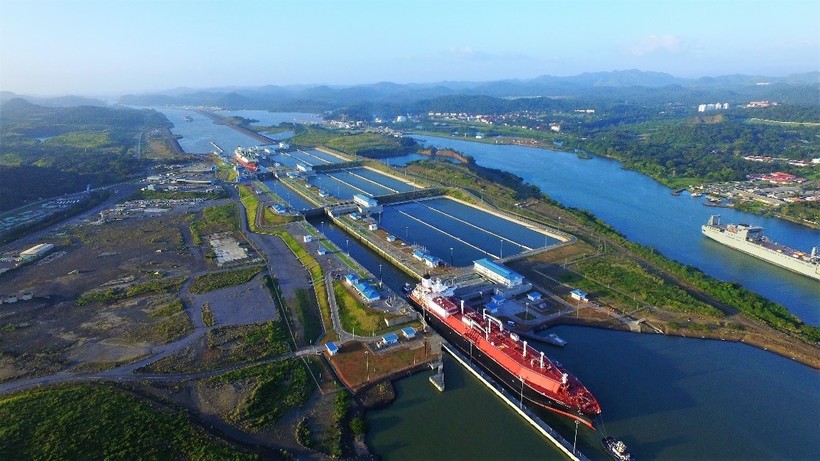Jorge Quijano, Administrator and CEO of the Panama Canal Authority sets the record straight on the facts on the Panama Canal in the HuffPost.
he Facts About Transits at the Panama Canal
Recent claims have surfaced that the Panama Canal faces challenges in servicing the true traffic demands of its liquefied natural gas (LNG) segment. Quite simply, these are not accurate. As part of its ongoing commitment to transparency, the Panama Canal would like to take the opportunity to clarify some information and address any concerns our customers and industry partners may have.
Here are the facts.
MYTH: The Panama Canal does not have enough capacity or equipment to efficiently transit incoming vessels.
FACTS:
- The Panama Canal has more than adequate capacity to tend to vessels transiting its Neopanamax locks. There are no Neopanamax vessels waiting to transit, there are no delays for customers with reservations at the Neopanamax locks, and we are servicing every vessel that comes our way for transit or port activity.
- Similarly, we have more than enough tugboats to service these vessel segments, including LNG. Since its pre-Expansion operations, the Panama Canal has doubled the number of tugboats it employs and tripled its fleet’s overall towing capacity. There are even times at which tug service providers at the entrances of the Canal are not being employed because the current demand can be handled with existing equipment.
- To accommodate increased traffic through the new locks, the Panama Canal also launched a state-of-the-art vessel scheduling and maritime resource management system to optimize resources, improve safety and increase the overall efficiency and reliability of the service it provides.
- As a result of its efficient operation and expanded capacity, the waterway welcomed a record 403.8 million Panama Canal tons in its fiscal year 2017, a 22.2 percent increase from the year before and the most in its 103-year history.
MYTH: The LNG industry needs more reservations than are currently available.
FACTS:
- Booking data, provided up to a year in advance, indicates that demand from the LNG industry to transit the Panama Canal is just shy of one vessel per day, or less than seven a week. Commensurate with this demand, the Canal offers LNG vessels one reservation slot a day.
- Frequently, even the LNG reservations which have been assigned go unused. Records show that only 60 percent of the LNG vessels that book a slot actually transit. These unused slots are normally released so close to the booked date it prevents other customers from using the reserved slot, resulting in lost capacity that affects the Panama Canal and its other segments.
- The reality is that the Expanded Panama Canal is averaging four LNG transits per week, considerably less than the seven reservation slots it makes available.
MYTH: Panama Canal operations are not transiting LNG vessels efficiently.
FACTS:
- Again, there are currently no delays at the Panama Canal for any vessel segment.
- In some instances, when LNG vessels arrive ahead of their reserved date, the Panama Canal has been able to advance their transits and provide even further time savings. However, 86 percent of the early arrivals this year chose not to transit ahead of time.
MYTH: The Panama Canal is unable to adapt to potential growth in terms of LNG demand.
FACTS:
- The Panama Canal works with industry representatives to ensure the safe, efficient and reliable operations of the waterway in a way that is ultimately fair for all segments. It will continue to undertake actions to ensure that the reserved spaces allotted for transits are used as planned.
- We believe the LNG industry is important to all, including the Panama Canal, and consequently will endeavor to seek ways to optimize the maritime transport chain through these discussions.
- The Canal has actually met with Cheniere Energy representatives, the only US LNG exporter making use of the waterway at this time. We are also working with all users of the Canal to promote efficiencies that could result in a better utilization of the available capacity, and we are meeting with buyers from Japan and Korea to establish annual delivery programs that will satisfy both their demand and our available capacity.
- As the number of LNG transits demonstrates a need for more capacity, the Canal is prepared to take steps to offer more reservations in the future.
- In fact, on December 17, 2017, the Panama Canal locked 11 Neopanamax vessels, including two fully loaded LNG vessels from Cheniere Energy in Sabine Pass.
The Panama Canal remains committed to the safe, reliable and efficient operation of its waterway. Despite claims to the contrary, we look forward to continuing to provide unparalleled service to all customers across all sectors. As the Expanded Canal ushers in a new era for maritime trade, we are excited to exceed the expectations of our customers, people and global maritime community.
Jorge L. Quijano
Panama Canal Administrator
